Documentary - Genres
General features of documentary films
Documentaries are films that capture and creatively process reality, thus differing from live-action and animated films. It is therefore a non-fiction genre whose origins date back to the emergence of cinema as such – the end of the 19th century. Over the years, the genre has constantly evolved, adapting to the development of technology and filmmaking techniques, while always reflecting its present, making its history also a history of the changes in human society. Documentaries also have an educational purpose, as they provide viewers with information about various topics, events and ideas, thus broadening their horizons, as well as allowing them to develop sensitivity and empathy towards the topics or the human lives depicted. The contributions of documentaries include, among other things, opening up important topics and preserving them for future generations, drawing attention to the problems of the world, shedding light on specific aspects of the issues documented, while also serving as a form of testimony, proclamation or investigative work.
Documentaries rely on capturing real events that are presented from the perspective of their authors and possibly supplemented by authentic testimonies or explanatory or informative commentary, which, however, should not misinterpret those events. They have the power to influence people's views on certain topics and their perception of the world, and documentary filmmakers are ethically responsible for the content of their work, which can become manipulative or propagandistic if its objectivity is compromised. However, some distortion of reality can also occur unintentionally, such as through editing, taking things out of context, insufficient reflection on cultural or contemporary differences, or the presence of a number of unintended interpretations. The filmmaker's point of view is represented by the camera, which, in addition to its ability to observe, also has the ability to communicate. The image can also be accompanied by authentic sounds (in documentary filming, sound is usually captured by contact) to deepen the experience.
Types and sub-genres of documentary films
The most common type of documentary is the so-called explanatory documentary, which presents information and reality directly to the viewer, using a narrator's voice in addition to the image; they are usually interpretive, with historical, war or natural history themes. In the case of some real historical events (e.g. those that are retrospectively condemned by society), they often include an indication of the author's position on the subject, likewise in documentaries dealing with pressing environmental issues. When describing events for which there is no contemporary film footage, they can replace it with fictional documentary reconstructions. In biographical documentaries, which traditionally tell the stories of public figures, contemporary records play an important role, and the narrative commentary can also be replaced or supplemented by witness testimony. In contrast, the so-called observational documentaries, which consider the captured audiovisual footage to be sufficiently eloquent and self-explanatory not to be accompanied by another interpretive voice that would unnecessarily interfere with the viewer's perception of the film, usually do without narrative commentary.
Those documentaries flourished in the 1950s and 60s and established themselves in two distinct streams: "Direct Cinema", a method developed by American filmmakers based on making a record of an event in progress, including authentic witness testimonies, with minimal intervention by the director, and "Cinéma vérité" a movement that took hold in Europe, which differed in the degree of intervention by the filmmaker, who used the camera and his own influence to stimulate discussion situations. In this respect, this type of documentary found itself on the border of participatory documentary, where authors can even take part in the captured events and thus become their main protagonists – but in such a case, the goal is usually no longer to capture reality objectively, but to capture it emotionally and in accordance with the authors’ own convictions. These include documentaries filmed from their own point of view, with the authors usually dealing with more personal topics, or self-reflexive documentaries, which, in addition to presenting a particular issue, the filmmaking process itself is also captured. Time-lapse documentaries, on the other hand, most often focus on the observation of a specific person (or several people), whose actual fate and life changes are depicted over a longer period of time during which the filming took place.
Footage of sporting events, music concerts or film shoots ("films about film") are also considered documentaries. Natural history as well as social and cultural themes are combined in travelogues aimed at providing insights into various exotic or attractive tourist destinations. Some documentaries have an appealing function, some serve as a form of protest or expression of opinion or position, while others expose various political affairs and thus serve to present someone's difficult investigative work. Some filmmakers approach documentaries as a poetic tool, conveying a new view of the world not through attitudes and opinions, but through an aesthetically exceptional production achieved through camera work, editing or animation. In contrast, television documentaries, in particular, emphasize informativeness rather than artistic form, making them more reminiscent of reports and other journalistic works.
Over the years, various hybrid forms of documentary have developed that mix fact and fiction, the most common of which are known as docu-fictions, i.e. documentaries containing acted or staged passages, and docu-dramas, which consist of fictional reconstructions of real events, filmed using documentary techniques. A special category are the mockumentaries (or docu-comedies), which are also filmed like regular documentaries, but their content is completely fictional and made up. The so-called pseudo-documentaries are not based on reality, but unlike mockumentaries, they are usually not made for comedic purposes. Close to pseudo-documentaries are also mondo films, exploitative documentaries dealing with various shocking, taboo and controversial topics, also called "shockumentaries". The term "found footage" is used to describe live-action films that are presented as real records of events, often passed off as footage taken by amateur filmmakers or security cameras, and filmed as such. Their antithesis are the "fake-fiction" films, which, on the contrary, present real documentary footage in the form of a feature film, thus making them look authentic.
The Arrival of a Train (1896)
Photo © Lumière

The Lumière Brothers and other early documentaries of the silent era
The forerunner of documentary film is photography and even older means of capturing reality like paintings, sculptures and other works of art. The Kinetoscope, a device for viewing moving images, was patented by Thomas Edison, whose invention of the motion picture camera was inspired by the invention of the cinematograph by brothers Louis and Auguste Lumière, the first film directors. Compared to Edison’s camera, their film equipment had the considerable advantage of a much smaller size and easier portability. Film as we know it today was born in 1895, together with the invention of the cinematograph. Though the brothers also made feature films, documentaries dominated their work, with them and their cameramen shooting them all over the world. They were roughly one minute long and consisted of a single shot, with the most frequent subjects being, of course, common everyday activities and various ordinary and extraordinary situations and events, for example The Arrival of a Train (1895), Employees Leaving the Lumière Factory (1985) or Demolition of a Wall (1986). But documentaries filmed in exotic countries that provided evidence of the local way of life were also popular.
The very first feature film in the history of cinema was, coincidentally, a documentary, a sports film called The Corbett-Fitzsimmons Fight (1897), a recording of a boxing match. At the turn of the century, film was used for scientific reasons and to capture real surgical procedures. Documentaries dominated cinema from the moment of its creation for more than a decade before they were overtaken by feature films of other genres with fictional plots. Especially popular were travelogues taken in various places around the world, and the first biographical documentaries began to appear. The docu-fiction In the Land of the Head Hunters (1914), set among indigenous peoples of North America, stood high above the standard of conventional travelogues of its time, and was followed shortly after by South (1919), which focused on the then unsuccessful British Royal Expedition across Antarctica.
In the Land of the Head Hunters (1914)
Photo © Seattle Film Co.
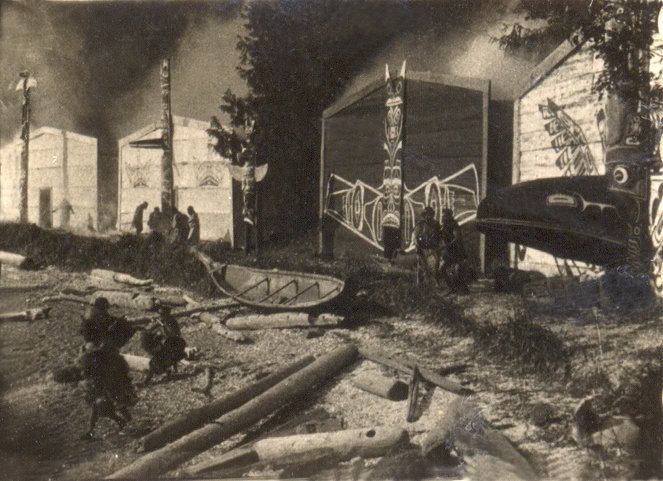
The Soviet montage school and other documentaries of the 1920s
One of the most famous documentaries of the 1920s was the feature-length semi-fiction film Nanook of the North (1922), whose director, the American Robert J. Flaherty, used the method of staging in front of the camera to depict the dramatic life of an Inuit family, including the building of igloos and walrus hunting. Similarly exotic were Grass: A Nation's Battle for Life (1925), which followed the fate of a tribe of Persians during their migration, Chang (1927), which depicted the fate of a Thai indigenous family living in the jungle and battling wild animals, and Flaherty's next work, Moana (1926), which followed the plight of indigenous people in the Pacific. Flaherty's documentaries inspired Scottish filmmaker and producer John Grierson, who promoted the idea of using documentary to highlight social issues and was behind the emergence of the British documentary movement in the 1930s, although he directed only one film himself, Drifters (1929), a documentary on various aspects of North Sea fishing. The French director Jean Epstein began his documentary series on Brittany with Finis terrae (1929).
In the Soviet Union, documentaries served mainly propagandistic and didactic purposes, recapitulating the events of the Russian Revolution, depicting human society in everyday activities, and educating in communist ideas. The main trend in filmmaking at the time was the Soviet montage school, defined by the method of recutting filmed material. For example, the documentary The Fall of the Romanov Dynasty (1927) was made by cutting footage from the personal film archive of the Russian Tsar Nicholas II, and the series of agitprop films by Dziga Vertov known as Kino-Pravda (1922-1925), based on creatively edited footage made for newsreels, was also significant in this respect.
Vertov later became famous for his experimental documentary Man with a Movie Camera (1929), in which he authentically captured the life of a city using the method of "catching life in the act", which opened up new ways of perceiving reality, with the camera playing the role of a "cinema-eye", a kind of dynamically moving mechanical eye. In addition, Vertov used a number of technical tricks in his artwork and interspersed scenes of busy streets with shots of the cameraman at work, thus thematising the making of the film itself. The German documentary filmmaker Walter Ruttmann was also extremely creative, filming unsuspecting people with a hidden camera in his avant-garde Berlin: Symphony of a Great City (1927). But thematically similar "city symphonies" were being composed at the same time elsewhere in the world, e.g. in the USA (Manhatta, 1921), in France (Nothing But Time from 1926, Studies on Paris from 1928), and in Brazil (São Paulo, a Metropolitan Symphony, 1929).
Man with a Movie Camera (1929)
Photo © VUFKU
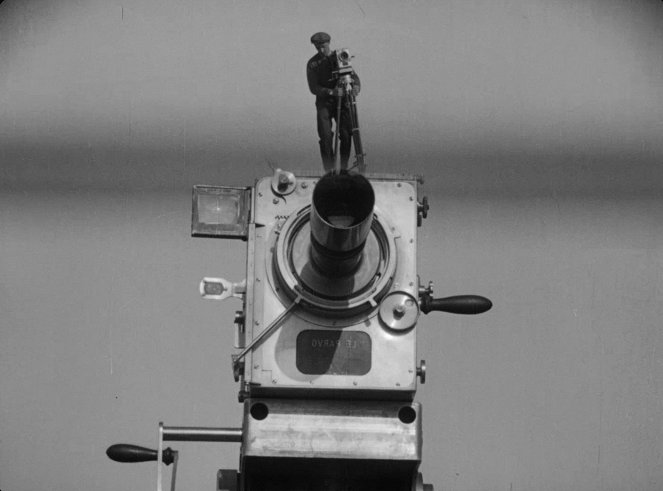
Propaganda and other documentaries in the 1930s and 40s
Although the approaching Second World War in the 1930s greatly contributed to the development of documentary filmmaking, the genre also moved away from the concept of objectively capturing reality and became a tool of war propaganda. Two of the most famous documentaries of this type were Leni Riefenstahl's Victory of the Faith (1933) and, in particular, Triumph of the Will (1935), which captured the 6th Reich Congress of the NSDAP and presented Hitler and his Nazi leaders as heroes, and later became the target of criticism in many countries after the end of the war. Even more controversial and criticized was the anti-Semitic pseudo-documentary The Eternal Jew (1940), which was essentially a preparation for the Holocaust, since its purpose was to vilify members of the Jewish people. Campaign in Poland (1940), on the other hand, depicted the course of the Nazi military campaign in that country, portraying the Poles as aggressors and oppressors.
On the other side of the conflict, in the USA Frank Capra directed a series of war documentaries during World War II, beginning with Prelude to War (1942), which was financed by the government and also used for propaganda purposes. Director William Wyler made the award-winning documentary The Memphis Belle: A Story of a Flying Fortress (1944), which focused on the famous bomber that operated over Germany in 1942 and 1943. In contrast, John Huston's anti-war documentary Let There Be Light (1946), about soldiers suffering from post-traumatic stress disorder, was confiscated by the military for its content and would not be declassified until the 1980s.
In the UK, the 1930s saw the founding of the Royal Film Society and the emergence of the British documentary movement, which addressed social issues and advocated that documentaries should have a social mission. In addition to the aforementioned John Grierson, the leading figures included Basil Wright (Night Mail, 1936), Alberto Cavalcanti (Mastery of the Sea, 1940), Harry Watt (Target for Tonight, 1941) and Humphrey Jennings (Fires Were Started, 1943). Coal Face (1935) was an insight into the lives of miners and the structure of the British mining industry, while Housing Problems (1935) dealt with the appalling conditions of people living in London's slums, and films such as London Can Take It! (1940) and Listen to Britain (1942) told the story of the effects of the war on ordinary people. The Oscar-winning documentary Desert Victory (1943) dealt with the campaign in North Africa, and Calling Mr. Smith (1943) was one of the first anti-Nazi propaganda films.
In the US, many documentaries focused on life, environmental problems and other social phenomena during the Great Depression. Of particular note in this regard are The Plow That Broke the Plains (1936), which recorded the transformation of the landscape as a result of human agricultural activity, The River (1938), which highlighted the effects of soil erosion in the Mississippi River basin, and The City (1939), which focused on the development of American cities. The Belgian documentary Misery in the Borinage (1933) depicted the exploitation of workers in a Belgian coal mine, while the American film The Spanish Earth (1937) dealt with the ongoing Spanish Civil War. Robert J. Flaherty returned to his staged documentary method in Man of Aran (1934), which captured fishermen at work off the Irish coast, and Louisiana Story (1948), set in rural Louisiana. Spanish director Luis Buñuel capped his early creative period with Land Without Bread (1933), a surreal documentary about an impoverished region of Spain, and Leni Riefenstahl celebrated success with a two-part film series consisting of Olympia Part One: Festival of the Nations (1938) and Olympia Part Two: Festival of Beauty (1938), in which she captured the 1936 Olympic Games in Berlin. After the end of World War II, however, documentary filmmaking in the West fell into silence for a while because it was too closely linked to propaganda, and because it gradually began to compete with television documentaries.
Triumph of the Will (1935)
Photo © Leni Riefenstahl-Produktion
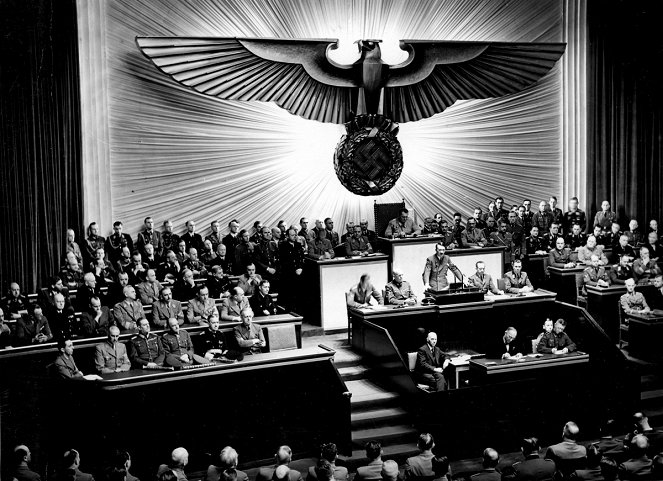
Cinéma vérité and other documentary movements
Documentary film production was greatly facilitated by technological advances in the 1950s. Portable tape recorders made it possible to capture sound simultaneously with the image, and lighter cameras made it possible to film with a much smaller crew. In addition, television began producing a greater range of documentaries, contributing to the development of various sub-genres, the most common of which were nature, historical and biographical documentaries, which did not place too great demands on artistic execution. Changes in the processes involved in documentary filmmaking also led to a desire to explore new realms of cinematic realism, resulting in the establishment of various movements around the world: Cinéma vérité in France, USA Direct Cinema in the USA, and Free Cinema in the UK, which consisted mainly in the production of short documentaries dealing with the life of working people and the inhabitants of working-class neighbourhoods. The main representatives of this movement were, among others, Karel Reisz (We Are the Lambeth Boys, 1959) and Lindsay Anderson (the Oscar-winning Thursday's Children, 1955, and Every Day Except Christmas, 1957).
In France, director Alain Resnais made his mark with several short documentaries, including the biographical Van Gogh (1948) and Paul Gauguin (1950), Guernica (1950) and All the World's Memories (1956), while Night and Fog (1956) was about Nazi concentration camps. Another remarkable documentary was the short Blood of the Beasts (1949), by Georges Franju, that combined the theme of slaughtering animals in abattoirs with footage of everyday life in Paris. The founders of Cinéma vérité, however, were the documentary filmmakers Edgar Morin and Jean Rouch, who tried to follow in the footsteps of Dziga Vertov and his "cinema of truth". Their documentary Chronicle of a Summer (1961), which involved addressing people on the street as part of a sociological survey, became a manifesto for Cinéma vérité and was the first French feature film ever made with contact sound. Other directors associated with this movement include Chris Marker (The Lovely Month of May, 1963), Mario Ruspoli (Strangers of the Earth, 1961) and Marcel Ophüls (The Sorrow and the Pity, a four-hour documentary about France during the Nazi occupation, 1969).
The American Direct Cinema movement also emerged in the early 1960s, but it differed from Cinéma vérité in the complete absence of any intervention by the filmmakers in the action. Its founders included Robert Drew (Primary, 1960), Richard Leacock (Happy Mother's Day, 1963) and brothers Albert and David Maysles (Salesman, 1969). Other important representatives include D. A. Pennebaker, whose film about the backstage of a Bob Dylan's British concert tour, Don’t Look Back (1967), was at the birth of the popularity of music documentaries, and Frederick Wiseman, who shot several of his films in state institutions such as a mental hospital (Titicut Follies, 1967), a high school (High School, 1968), a New York hospital (Hospital, 1970), a juvenile court (Juvenile Court, 1973) and a welfare institution (Welfare, 1975). The Direct Cinema method was also used by some Canadian documentary filmmakers, such as Michel Brault (The Snowshoers, 1958), Pierre Perrault (For Those Who Will Follow, 1962) and Allan King (A Married Couple, 1969).
The Sorrow and the Pity (1969)
Photo © Télévision Rencontre / SSR / NDR

Other notable documentaries of the 1950s and 60s
The documentary Four Days in November (1964) used countless news footage and other video materials to create a detailed account of the circumstances surrounding the assassination of President John F. Kennedy, while the Oscar-winning The Eleanor Roosevelt Story (1965) explored the personality of President Roosevelt's wife. The Soviet documentary Triumph Over Violence (1965) used the example of the fascist regime to highlight the dangers of the emergence of totalitarian ideologies. The British television sociological experiment called Seven Up! (1964), which followed fourteen seven-year-old children from different socio-economic backgrounds and then returned to their fates every seven years, was quite impressive. It was the first film in a time-lapse documentary series directed by Paul Almond in collaboration with emerging filmmaker Michael Apted, who himself made further episodes in 1970 (Seven Plus Seven), 1977 (21 Up), 1985 (28 Up), 1991 (35 Up), 1998 (42 Up), 2005 (49 Up), 2012 (56 Up), and 2019 (63 Up).
Several nature documentaries met with success, one of the first was the American The Living Desert (1953), which won an Oscar for its depiction of animal life in the desert regions of the American Southwest, and the Oscar-winning French film The Silent World (1956), which was directed by the famous oceanographer Jacques-Yves Cousteau and portrayed the diversity of life under the sea. The documentaries by Austrian filmmaker Hans Hass Adventures in the Red Sea (1951) and Under the Caribbean (1954) also attempted to map the underwater world. The sports documentary The Endless Summer (1966) became a phenomenon, it followed the adventures of two surfers and changed society's view of the previously misunderstood surfing community.
In Italy, the term "mondo film" was born in the 1960s to refer to exploitation documentaries with shocking, taboo and generally controversial contents. The first documentary made with the intention to shock, and which gave the sub-genre its name, was Mondo Cane (1962), which was followed by, among others, Women of the World (1963), Taboos of the World (1963), Africa Addio (1966), the American Mondo Topless (1966), and the German Shocking Asia (1976). The filmmaker Pier Paolo Pasolini also chose a sensitive subject for his documentary Love Meetings (1964), which explored the creation of an inquiry into questions of human intimacy and sexuality during a journey across Italy.
The Silent World (1956)
Photo © Rank
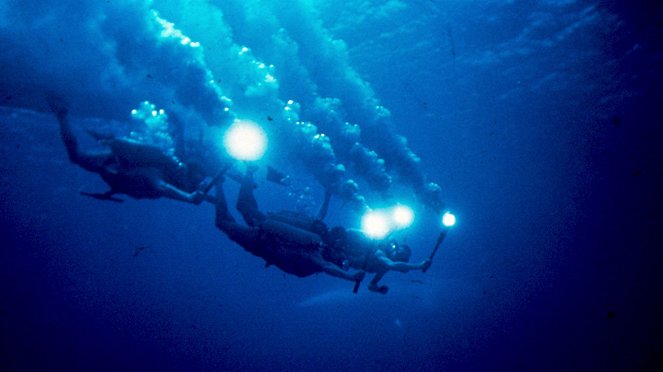
Music and political documentaries at the turn of the 1960s and 70s
After D.A. Pennebaker’s Don’t Look Back, music documentaries became a phenomenon, which Pennebaker himself furthered with his subsequent film Monterey Pop (1968), a cross-section of a three-day international music festival held in California in 1967. 1970 was an exceptional year in terms of music documentaries, with Gimme Shelter, filmed during a tragic Rolling Stones concert where one of their fans was stabbed to death, and Let It Be, about the Beatles at the end of their existence, Elvis, about Elvis Presley's four-week stint in a Las Vegas hotel, and three-hour Woodstock, which was awarded an Oscar for documenting one of the biggest rock events in history. Jean-Luc Godard's music film Sympathy for the Devil (1968) straddled the line between documentary and fiction, Elvis Presley: On Tour (1972) followed the King of Rock 'n' Roll, and Imagine (1972) was made by John Lennon and Yoko Ono about themselves and their songs. The musical docu-drama Jimi Hendrix - Rainbow Bridge (1972) analysed the lifestyle of hippies against the backdrop of a Hendrix concert in Hawaii, Janis - The Way She Was (1974) combined various musical performances by Janis Joplin with authentic accounts of her life, and The Last Waltz (1978), directed by Martin Scorsese, became not only a record of The Band's last ever concert, but also a portrait of the 1970s rock scene.
At the same time, from the second half of the 1960s onwards, many documentaries dealt with controversial political issues and explored fundamental social phenomena, thus becoming critical tools for advocating certain views and opinions. Several famous directors contributed to the documentary Far from Vietnam (1967), made in protest against the American intervention in the Vietnam War, and In the Year of the Pig (1969) and Hearts and Minds (1974) also dealt with the same theme. Many documentary filmmakers where influenced by The Hour of the Furnaces (1968), a three-part Argentine film of more than four hours that criticised capitalism, neo-colonialism and the Argentine military regime, and called for freedom and revolution. The Japanese documentary Minamata: The Victims and Their World (1972) discussed the affair of a factory that caused an ecological disaster, numerous illnesses and the death of dozens of people by discharging waste into the surrounding waters.
The Band in Concert - The Last Waltz (1978)
Photo © Metro-Goldwyn-Mayer (MGM)

Other important documentaries of the 1970s
In line with the Direct Cinema movement, brothers Albert and David Maysles, in collaboration with other filmmakers, made Grey Gardens (1975), a documentary based on the strong relationship between two women, mother and daughter, from Jackie Kennedy's family. The same observational method was used by Barbara Kopple in her Oscar-winning Harlan County, U.S.A. (1976), about a more than year-long miners' strike in Kentucky. German director Werner Herzog focused on the lives of the deaf-blind in his documentary Land of Silence and Darkness (1971), Martin Scorsese told the history of his family and the Italian community in New York in Italianamerican (1974), and Orson Welles focused on fraud and hoaxes in art in F for Fake (1974). The California Reich (1975) focused on neo-Nazi groups operating in various California cities, while Germany in Autumn (1978) depicted the atmosphere in West Germany after the RAF attacks. There were also biographical documentaries about controversial figures such as the Ugandan President (Idi Amin Dada, 1974) and Adolf Hitler (Hitler: The Whole Story, 1977).
Sports documentaries found suitable subjects, for example, in the 1972 Munich Olympics (Visions of Eight, 1973), in bodybuilding, led by multiple champion and aspiring actor Arnold Schwarzenegger (Pumping Iron, 1977), or in formula racing and its risks for drivers (Speed Fever, 1978). The British compilation documentary Brother, Can You Spare a Dime? (1975) consisted of period footage depicting the Great Depression of the 1930s, while That's Entertainment! (1974) and its sequel That's Entertainment, Part II (1976) served as guides to the world of Hollywood musicals. The comedic South African nature documentary Animals Are Beautiful People (1974) stood out because it depicted animals doing unconventional activities and compared their behaviour to that of humans.
F for Fake (1974)
Photo © Les Films de l'Astrophore, SACI, Janus Film und Fernsehen
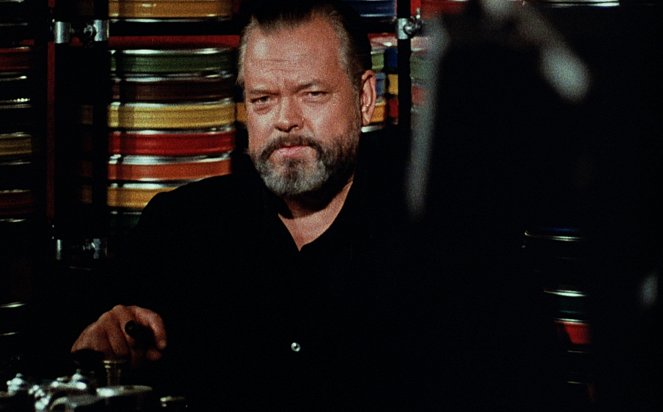
Errol Morris, Godfrey Reggio and documentary in the 1980s
Errol Morris, who made his directorial debut with Gates of Heaven (1978), a documentary revolving around the relocation of an animal cemetery, became a prominent figure in the 1980s scene and his next film, Vernon, Florida (1981), was a portrait of the quirky residents of a small Florida town. His most famous work, however, was the investigative film The Thin Blue Line (1988), which demonstrated in practice the power and impact of documentaries on real human lives. It dealt with an investigation into the 1976 murder of a police officer, and Morris used a combination of interviews and fictional reconstructions to highlight a number of ambiguities in the case, ultimately helping to save a wrongly convicted man from the death penalty and freeing him from prison. The more than nine-hour documentary colossus Shoah (1985), directed by Claude Lanzmann, was also a major socio-cultural phenomenon. It was a unique and comprehensive insight into the Holocaust, consisting exclusively of testimonies from eyewitnesses and concentration camp survivors. Another important documentary was Atomic Café (1982), which looked at the impact of the atomic bomb on human society, starting with the first nuclear test in 1945.
The documentary filmmaker Godfrey Reggio also established his unique style, first in his meditative visual collage Koyaanisqatsi (1982), where he wordlessly commented on human existence in a technocratic society, and then used the same method in Powaqqatsi (1988), which focused on life in developing countries and the remnants of indigenous cultures. He later completed his civilization trilogy with Naqoyqatsi (2002), which highlighted the fundamental problems of the modern world in which man is increasingly heading towards his own extinction. Also noteworthy is his short documentary Anima Mundi (1992), which explores the beauty of nature threatened by human activity.
The music documentary The Decline of Western Civilization (1981) focused on the Los Angeles punk scene, Stop Making Sense (1984) was a concert film about a Talking Heads performance, and Depeche Mode: 101 (1989) captured that band at the height of their career. The documentary Burden of Dreams (1982) was about the making of the Werner Herzog film Fitzcarraldo. The Oscar-winning biographical documentary The Times of Harvey Milk (1984) focused on the first openly gay politician in the history of California, the Oscar-winning Hotel Terminus: The Lives and Times of Klaus Barbie (1988) was a portrait of the namesake Nazi war criminal who became known as the "Butcher of Lyon", and Let's Get Lost (1988) focused on jazz trumpeter Chet Baker. There were many other biographical documentaries, including Bruce Lee, the Legend (1984), Antonio Gaudí (1984), Marilyn Monroe: Beyond the Legend (1987), Imagine: John Lennon (1988), and Directed by Andrei Tarkovsky (1988). Also worth mentioning are two remarkable mockumentaries: a fictional biography of a man called Zelig (1983) and a music documentary about a fictional hard-rock band This Is Spinal Tap (1984). The controversial Italian horror film Cannibal Holocaust (1980), in which a group of filmmakers go to the Amazon to film a tribe of cannibalistic natives and are supposedly killed and eaten by them at the end of the film, was also passed off as a documentary.
Koyaanisqatsi: Life Out of Balance (1982)
Photo © Island Alive / New Cinema
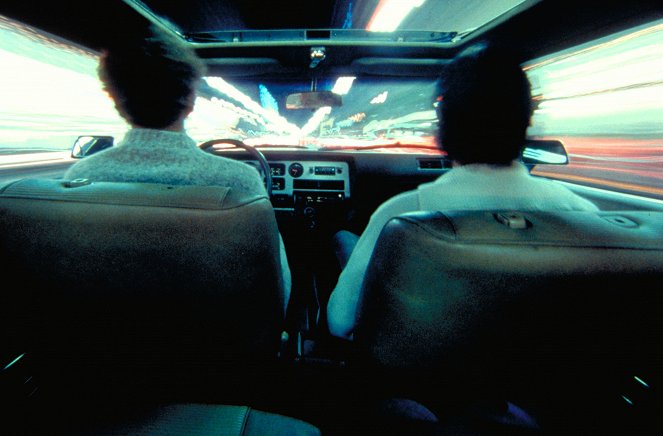
Werner Herzog, Ulrich Seidl and documentary in the 1990s
Barbara Kopple returned to documentaries and the subject of striking workers with American Dream (1990), which, like her debut, was also awarded an Oscar. Her other films include Wild Man Blues (1997), about the European tour of the jazz band of Woody Allen, who a few years before had gone through a difficult period in his life. Another music documentary was Wim Wenders's Buena Vista Social Club (1999), whose protagonists were Cuban musicians. Jennie Livingston's documentary Paris Is Burning (1990) was a probe into parties in the LGBTQ community, while The Celluloid Closet (1995) told the history of the portrayal of homosexuality in Hollywood. The film Waco: The Rules of Engagement (1997) uncovered an investigation into the affair surrounding the US law enforcement crackdown on members of a religious sect that resulted in dozens of people killed after the nearly two-month siege of their headquarters. The documentary The War Room (1993) revolved around Bill Clinton's presidential campaign, Spike Lee's 4 Little Girls (1997) referred to the 1963 bombing of an Alabama church for African-Americans that killed four girls, and the Oscar-winning One Day in September (1999) took on the actions of a Palestinian terrorist group at the Munich Olympics.
German filmmaker Werner Herzog followed up his documentary work with, among others, Lessons of Darkness (1992), a cinematic essay on the theme of destruction in man and in the world, Little Dieter Needs to Fly (1997), the story of a German U.S. Army pilot who managed to escape from enemy captivity during the Vietnam War, and My Best Fiend (1999), a reflection on his own complicated working relationship with his court actor Klaus Kinski. Austrian documentary filmmaker Ulrich Seidl directed Loss Is to Be Expected (1992), a docudrama about frontier love, and then found his way into the method of filming strange people with strange predilections in Animal Love (1996), a documentary whose protagonists were real pet lovers. Dušan Hanák's documentary Paper Heads (1995) covered the political situation in Czechoslovakia between 1945 and 1989, while the atmosphere shortly after the Velvet Revolution and the subsequent break-up of Czechoslovakia was captured by documentary filmmaker Karel Vachek in his philosophical-sociological essays New Hyperion or Liberty, Equality, Brotherhood (1992) and What Is to Be Done (1996). In France, nature documentaries thrived, with director Luc Besson enchanting with his dive into the underwater world in Atlantis (1991), followed by Microcosmos (1996), whose authors Marie Pérennou and Claude Nuridsany, developed a special camera for capturing close-ups of insects and small animals.
Biographical documentaries dealt with personalities such as singer Madonna (Madonna: Truth or Dare, 1991), scientist Stephen Hawking (A Brief History of Time, 1991), actor Bruce Lee (Curse of the Dragon, 1993), cartoonist Robert Crumb (Crumb, 1994) and boxer Muhammad Ali (the Oscar-winning When We Were Kings, 1996). The strikingly visual documentary Baraka (1992) was a wordless pilgrimage through various cultures and civilisations, the sports documentary Hoop Dreams (1994) followed a pair of African-American high school students over six years to their stellar careers in the NBA, and the Canadian film Grass (1999) explored the history of marijuana use in the USA and the government's efforts to regulate it. The documentary Hearts of Darkness: A Filmmaker's Apocalypse (1991) charted the problematic making of Francis Ford Coppola's war film Apocalypse Now, while Beyond JFK: The Question of Conspiracy (1992) looked at the making of Oliver Stone's drama JFK.
In the four-hour documentary A Personal Journey with Martin Scorsese Through American Movies (1995), the famed director commented on a cross-section of iconic works of Hollywood cinema. The documentary Trekkies (1997) gave an insight into the Star Trek fan community, and American Movie (1999), about a film enthusiast who tried to finish his amateur horror film and make it as an independent filmmaker, was also a hit. Also notable was the Belgian mockumentary Man Bites Dog (1992), in which a documentary crew follows and films a serial killer on his bloody rampage. The feature horror film The Blair Witch Project (1999) was also made as a documentary, and at the time of its release it was presented as authentic camera footage taken by a group of students who had lost their way in the woods under strange circumstances.
The end of the 1990s and the beginning of the new millennium were accompanied by three fundamental aspects in terms of documentary filmmaking (or filmmaking in general): the widespread use of the Internet, the adoption of digital technologies by the film industry, and the falling prices of handheld cameras. Thanks to these three factors, the possibilities of making films and especially documentaries were opened up to a much larger number of filmmakers who could now shoot and edit their own films with their own equipment, which in turn lead to an increase in the number of documentaries with personal stories in which the authors depict themselves or their loved ones. The turn of the millennium also saw an increase in the number of documentaries that achieved unusual financial success in cinemas, with their earnings in many cases boosted by their release on DVD.
Lessons of Darkness (1992)
Photo © Werner Herzog Filmproduktion
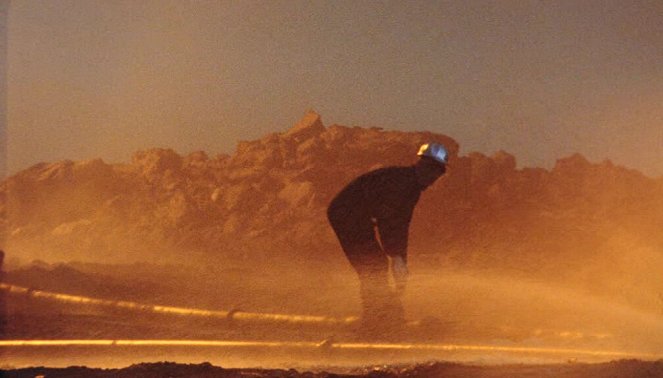
Michael Moore and other documentarists of the new millennium
Michael Moore, an independent filmmaker who explored the shortcomings of corporate America, its politics and social ills, became a prominent figure of American documentary at the very beginning of the new millennium. In his documentaries, he often plays the role of the main protagonist and a kind of guide, who doesn’t hesitate to commit a series of manipulations and misleading work with information when expressing his views and to sway public opinion to his side even through humour and subliminal messages. He made his debut in 1989 with the highly successful Roger & Me (1989), in which he dealt with the mass layoffs at a car factory that caused the economic collapse of his hometown. He also addressed the mistreatment of workers in multinational corporations in The Big One (1997) and in Capitalism: A Love Story (2009).
He achieved considerable success when he won an Academy Award for Bowling for Columbine (2002), whose title refers to the Columbine High School massacre, and in which Moore took on the American firearms market. His highly controversial Fahrenheit 9/11 (2004), the highest-grossing documentary in the history of cinema at the time, was made to discredit US President George W. Bush in the run-up to the election and to accuse him of a multitude of offences, both before and after September 11, 2001. He would also work with public opinion while shooting the documentary Captain Mike Across America (2007), and his next film, Sicko (2007), was a probe into American health care issues, while in Where to Invade Next (2015), he compares the U.S. to various European countries, and in Fahrenheit 11/9 (2018), he again focuses on a presidential election, this time with candidate Donald Trump at the forefront.
Another notable sports documentary filmmaker was Stacy Peralta, who burst onto the scene with Dogtown and Z-Boys (2001), a documentary about skateboarders, followed up with Riding Giants (2004), about surfers, and returned to skateboards in Bones Brigade: An Autobiography (2012). In Crips and Bloods: Made in America (2008), however, he focused on two black gangs in Los Angeles. Another popular figure in the documentary field was Morgan Spurlock with the experiment Super Size Me (2004), where he takes aim at obesity in the USA eating exclusively in fast food restaurants for a month and became a social phenomenon. Spurlock also starred in his other documentaries Where in the World Is Osama Bin Laden? (2008), The Greatest Movie Ever Sold (2011), Mansome (2012), and Super Size Me 2: Holy Chicken! (2017).
The famous documentary filmmaker Errol Morris enjoyed a career revival with his Academy-Award-winning The Fog of War: Eleven Lessons from the Life of Robert S. McNamara (2003), which was conceived as a confession of the US Secretary of Defence who served in that position during the Vietnam War. Morris later repeated this model in The Unknown Known (2013), whose protagonist was Secretary of Defence when the US military operations in Afghanistan and Iraq were launched. Before that, however, he made a documentary about the inhumane practices in Baghdad's prison for political prisoners, Standard Operating Procedure (2008), and then Tabloid (2010), where he analysed the curious case of a former beauty queen turned kidnapper in the 1970s. Director Werner Herzog expanded his documentary portfolio with Grizzly Man (2005), the story of an environmentalist who spent many years among bears, and Encounters at the End of the World (2007), which focused on the lives of researchers in the harsh environment of Antarctica.
Czech director Helena Třeštíková became a promoter of the time-lapse documentary using her method to film the fates of various people over several years, giving rise to the documentaries Marcela (2006), René (2008), Katka (2009), Mallory (2015) and The Strnads (2017). In his four-part documentary series Forgotten Transports to... (2007-2010), historian Lukáš Přibyl explored the lesser-known transfers of deported Jews to concentration camps and ghettos in Latvia, Estonia, Belarus and Poland. Slovak documentary filmmaker Pavol Barabáš became become a prominent personality in the field of travelogues thanks to his films Mysterious Mamberano (2000), OMO - A Journey to the Primaeval Age (2002), Amazonia Vertical (2004) and dozens of others.
Roger & Me (1989)
Photo © Warner Bros. Pictures
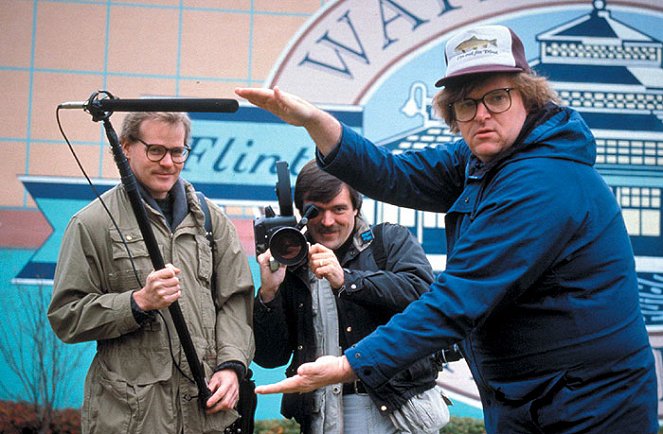
Other significant documentaries after 2000
The subjects of documentaries varied from the Rwandan genocide (The Last Just Man, 2002), criticism of multinational corporations (The Corporation, 2003), sexual abuse of minors (Capturing the Friedmans, 2003) and the abuse and killing of animals for human purposes (Earthlings, 2005) to the rise of the cocaine mafia in Miami (Cowboy Cocaine, 2006), the US invasion of Iraq (No End in Sight, 2007), and Burma's anti-government demonstrations (Burma VJ: Reporting from a Closed Country, 2008). The documentary Darwin's Nightmare (2004) described various global issues from the fish trade to the arms trade; Workingman's Death (2005) dealt with various forms of hard labour, the Oscar-winning Taxi to the Dark Side (2007) criticized the interrogation practices of the US military in the case of an Afghan taxi driver, Food, Inc. (2008) offered a look at big business in food production, and Bigger Stronger Faster* (2008) focused on bodybuilding and the moral aspect of steroid use. The Oscar-winning animated Waltz with Bashir (2008), which revisited the massacres in Palestinian refugee camps in the 1980s, stood out for its remarkable documentary form.
A contrast to these serious films were lighter documentaries about, for example, collectors (The Gleaners and I, 2000), children's spelling bees (Spellbound, 2002), American movie accessibility ratings (This Film Is Not Yet Rated, 2006), the history of competitive arcade video gaming (The King of Kong, 2007), and behind-the-scenes looks at Pixar's animation (The Pixar Story, 2007) and Walt Disney's studios (Waking Sleeping Beauty, 2009). The comedy documentary Religulous (2008) was a satirical insight into religious fanaticism, and the documentary-styled comedy Borat (2006), whose fictional story was supplemented by authentic confrontations between various Americans and the fictional character of a strange Kazakh reporter, also worked heavily with satire.
The music documentary Michael Jackson's This Is It (2009), about the preparations for a concert that never took place, was released shortly after the singer's death and became the highest-grossing documentary in the history of cinema. Other music documentaries include one about the members of Metallica (Metallica: Some Kind of Monster, 2003), the post-punk band Joy Division (Joy Division, 2007), a series of small concerts by Sigur Rós (Sigur Rós – Heima, 2007), and metal as a musical genre in general (Metal: A Headbanger's Journey, 2005). There were also many prominent nature documentaries, such as The Travelling Birds (2001), Deep Blue (2003), Genesis (2004), the Oscar-winning March of the Penguins (2005), Sharkwater (2006), Animals in Love (2007), Arctic Tale (2007), The Meerkats (2008), and Oceans (2009), while the thematically related An Inconvenient Truth (2006), Earth (2007) and Home (2009) drew attention to environmental issues.
At the turn of the millennium, a number of documentaries about famous filmmakers, films and Hollywood history were made, including, Stanley Kubrick: A Life in Pictures (2001), Woody Allen: A Life in Film (2002), Charlie: The Life and Art of Charles Chaplin (2003), Easy Riders, Raging Bulls: How the Sex, Drugs and Rock ’N’ Roll Generation Saved Hollywood (2003), A Dekade Under the Influence (2003), Final Cut: The Making and Unmaking of Heaven’s Gate (2004), Midnight Movies: From the Margin to the Mainstream (2005), Inside Deep Throat (2005) or The Pervert’s Guide to Cinema (2006). Comprehensive documentaries about film, such as King Kong: Peter Jackson's Production Diaries (2005) or Dangerous Days: Making Blade Runner (2007), charted the making of major Hollywood hits, while Lost in La Mancha (2002), on the other hand, explored how the making of a single film was prevented by a series of unfortunate circumstances.
The biographical documentary The Power of Good: Nicholas Winton (2002) explored the heroic act of a man who secretly transported several hundred mostly Jewish children to Great Britain during the Nazi occupation of Czechoslovakia, while Man on Wire (2008) told the story of a street artist who decided to walk a tightrope between the buildings of the World Trade Center in the 1970s. Other personalities who became the subject of documentaries include photographer James Nachtwey (War Photographer, 2001), Hollywood producer Robert Evans (The Kid Stays in the Picture, 2002), rapper Tupac Shakur (Tupac: Resurrection, 2003), writer Charles Bukowski (Bukowski: Born into This, 2003), musician Bob Dylan (Bob Dylan: No Direction Home, 2005), Czech President Václav Havel (Citizen Havel, 2007), scientist Albert Einstein (Einstein, 2008), and pianist Glenn Gould (Genius Within: The Inner Life of Glenn Gould, 2009).
March of the Penguins (2005)
Photo © Buena Vista International

The big documentary boom after 2010
The increase in the volume of filmmaking in the 21st century was not without its impact on documentaries, which began to appear in abundance, covering a wide variety of topics that included, among others, the economic crisis of 2008 (the Oscar-winning Inside Job, 2010), war propaganda in modern media (The War You Don't See, 2010), mass killings in Indonesia in the 1960s (The Act of Killing, 2012), and doping in competitive cycling (the Oscar-winning Icarus, 2017). Documentaries also addressed the problems of the digital age ranging from the collection of data from private electronic conversations (the Oscar-winning Citizenfour, 2014) to the negative effects of social networks (The Social Dilemma, 2020). The documentary I Am Not Your Negro (2016) recounted the history of African Americans' struggles against white supremacy, while 13th (2016) explored the theme of modern slavery in the American prison system. The compilation documentary They Shall Not Grow Old (2018) consisted of archival footage from World War I that was digitally restored and converted to colour. The investigative documentary Collective (2019) offered a disillusioning portrait of the Romanian healthcare system, while the authentic confession For Sama (2019) was shot on the streets of Syria during the civil war.
The works on less serious topics include documentaries about the preparation of sushi (Jiro Dreams of Sushi, 2011), the American space programme (Apollo 11, 2019) and the life of a Macedonian beekeeper (Honeyland, 2019). The documentary Babies (2010) charted the lives of four toddlers from different parts of the world, while The Other F Word (2011) focused on punk rockers turned fathers. The film Searching for Sugar Man (2012) won an Oscar for its portrayal of Rodriguez, a musician who became a rock legend in the 1970s without knowing it. There were also several mockumentaries and found-footage films with contents that varied thematically from the search for Norwegian trolls (The Troll Hunter, 2010) to vampire life in New Zealand (What We Do in the Shadows, 2014).
The already considerable number of nature documentaries grew even further with African Cats: Kingdom of Courage (2011), One Life (2011), Planet Ocean (2012), Polar Bears: A Summer Odyssey (2012), Chimpanzee (2012), Bears (2014), Seasons (2015), Tale of a Lake (2016), March of the Penguins 2: The Next Step (2017), Earth: One Amazing Day (2017), Planeta Czechia (2017), Untamed Romania (2018), and The Elephant Queen (2018). The documentaries Blackfish (2013) and Keiko the Untold Story of the Star of Free Willy (2013) dealt with the fates of two particular killer whales, while the Oscar-winning My Octopus Teacher (2020) told the story of a filmmaker's special friendship with a curious cephalopod. The Cove (2009), The Ivory Game (2016) and Sharkwater: Extinction (2018) tried to advocate for an end to the killing of wild animals, while Plastic Planet (2009) and A Plastic Ocean (2016) addressed the issue of marine plastic pollution. Racing Extinction (2015) also contributed to the issue of endangering animal species, while Lucent (2014), Cowspiracy: The Sustainability Secret (2014) and Dominion (2018) were critical of livestock production, and Taste the Waste (2010) criticized excessive food waste. The film David Attenborough: A Life on Our Planet (2020) served not only to recapitulate the career of the famous documentary filmmaker, but also to send an appealing message about the state of the environment.
Italian documentary filmmaker Gianfranco Rosi succeeded with his work reflecting on life around the Roman motorway (Sacro GRA, 2013), the refugee crisis (Fire at Sea, 2016) and the situation in the Middle East (Notturno, 2020). Ulrich Seidl, on the other hand, contributed to the theme of curious people with strange interests first with In the Basement (2014), a bizarre panopticon of several Austrian cellars and their owners, and then with Safari (2016), in which he visits the world of trophy hunters. Documentary filmmaker Dan Přibáň gave birth to an unconventional travelogue series consisting, among others, of Trabant Goes to Africa (2011) and Trabant at the End of the World (2014). The sports documentary Red Army (2014) covered the history of the Soviet hockey team, while The Nagano Tapes (2018) focused on the hockey matches from the Nagano Olympics and the rivalry between the Soviets and Czechoslovaks. Other sports documentaries include This Ain't California (2012) and King Skate (2018), both of which told the story of skateboarding in the socialist bloc countries, while The Crash Reel (2013) looked at snowboarding, Fastest (2011) and Hitting the Apex (2015) gave an insight into the world of motorcycle racing, and 1 (2013) looked at the history of formula racing. The Oscar-winning documentary Free Solo (2018) focused on the personality of mountaineer Alex Honnold and his perilous ascent of the rock wall of El Capitan, while The Dawn Wall (2017) also dealt with climbing an almost perpendicular massif without belay.
Director Asif Kapadia became a major force in documentary after achieving success with his film about F1 racer Ayrton Senna (Senna, 2010), then winning an Oscar for his documentary about singer Amy Winehouse (Amy, 2015), which he followed up with a film about footballer Diego Maradona (Diego Maradona, 2019). Other biographical documentaries revolved around personalities such as street art artist Banksy (Exit Through the Gift Shop, 2010), singers Lemmy Kilmister (Lemmy Forever, 2010), Ozzy Osbourne (God Bless Ozzy Osbourne, 2011), Freddie Mercury (Freddie Mercury: The Great Pretender, 2012) and Roger Waters (Roger Waters: The Wall, 2014), film critic Roger Ebert (Life Itself, 2014), guitarist Keith Richards (Keith Richards: Under the Influence, 2015), singer Kurt Cobain (Kurt Cobain: Montage of Heck, 2015), ballet dancer Sergei Polunin (Dancer, 2016), and porn actor Rocco Siffredi (Rocco, 2016). Other examples include actor Robin Williams (Robin Williams: Come Inside My Mind, 2018), judge Ruth Bader Ginsburg (RBG, 2018), singer Whitney Houston (Whitney, 2018), children's show host Fred Rogers (Won't You Be My Neighbor?, 2018), opera singer Luciano Pavarotti (Pavarotti, 2019), singer Taylor Swift (Miss Americana, 2020), activist Greta Thunberg (I Am Greta, 2020), and singer Billie Eilish (Billie Eilish: The World's a Little Blurry, 2021). There were also several documentaries about The Beatles and its members, such as George Harrison: Living in the Material World (2011), The Beatles: Eight Days a Week – The Touring Years (2016), How the Beatles Changed the World (2017), and Made on Merseyside – The Beatles (2018).
David Attenborough: A Life on Our Planet (2020)
Photo © Netflix
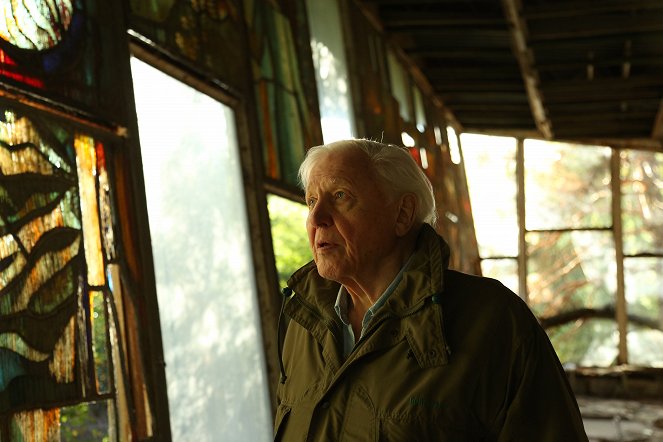
TV documentaries and documentary series
TV documentaries and documentary series have been produced in the United States and Great Britain since the late 1940s, with a strong focus on historical, wartime and news topics, such as the wartime series Crusade in Europe (1949) or The Armed Forces Hour (1949-1951). This trend continued in the 1950s with American documentary programmes such as The Big Picture (1951-1964), Wide Wide World (1955-1958) and The Twentieth Century (1957-1970) on NBC, ABC and CBS, while in Britain the BBC dominated the field. The pioneers of nature documentaries were the British series Zoo Quest (1954-1963) and the American Zoorama (1955-1970). The 1960s, later referred to as the golden age of TV documentaries in America, was rich in projects that were more engaged and political than in previous decades. Other productions of this era in the USA include travelogues (Expedition!, 1960-1962) and documentaries about Hollywood personalities (Hollywood and the Stars, 1963-1964). British productions of note include the war series The Great War (1964) and the nature series The World About Us (1967-1987) and Survival (1961-2001). In the 1970s, the TV documentary genre grew with other significant additions, including the American science series Nova (from 1974), the British science series Life on Earth (1979), the historical series The World at War (1973-1974) and the documentary series Everyman (1977-2000).
Over the following decades, interest in documentaries increased with cable television programming, and the number of films also grew considerably with the productions by specialty stations such as the Discovery Channel (from the 1980s), The History Channel and Animal Planet (from the 1990s), and National Geographic (early 21st century). Other programmes that started being produced in the USA include the biographical series American Masters (from 1985), the science series Cosmos (1980), the historical series The Civil War (1990) and the science series Nature (from 1982) and National Geographic Explorer (from 1985), while in the UK the programmes that became very popular include the natural history and science series The Natural World (1983), The Living Planet (1984) and The World of Strange Powers (1985), and in the 1990s, The Trials of Life (1990), The Private Lives of Plants (1995), The Human Body (1998), The Life of Birds (1998), The Planets (1999), and Walking with Dinosaurs (1999). Other productions include the British music documentary series The Beatles Anthology (1995) and the German war documentary series Hitler's Henchmen (1996-1998).
In the new millennium, the BBC built on its previous acclaim with another slew of highly praised and successful nature and science series, the most prominent of which were: Hyperspace (2001), The Blue Planet (2001), The Life of Mammals (2002-2003), Planet Earth (2006), Earth: The Power of the Planet (2007), Life (2009), Frozen Planet (2011), Planet Earth II (2016), Blue Planet II (2017), and Seven Worlds, One Planet (2019). The First World War (2003), World War II in Colour (2009), Doomsday – World War I (2012) and The Vietnam War (2017) all focused on military conflicts. Several French documentary miniseries from the Apocalypse series were also linked by the theme of war, of which Apocalypse: World War II (2009) and Apocalypse: World War I (2014) are particularly noteworthy. Other notable series include Zero Hour (2004-2007), Oliver Stone's Untold History of the United States (2012-2013), Making a Murderer (2015-2018) and Formula 1: Drive to Survive (2019-2021).
Filmmaniak
Best documentaries
David Attenborough: A Life on Our Planet (2020) |
Depeche Mode: Devotional (1993) |
The Alpinist (2020) |
The Dawn Wall (2017) |
Senna (2010) |
Dominion (2018) |
The Rescue (2021) |
The Cove (2009) |
Iron Maiden: Death on the Road (2006) |
Wayne Gretzky: Above and Beyond (1990) |
| All the best documentaries |